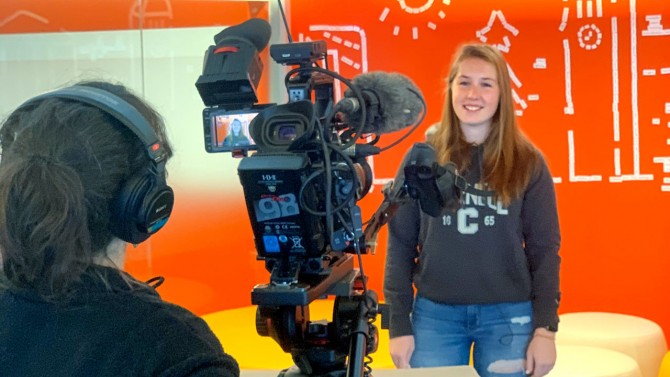
Brendon Gauthier ’21, an intern with the university’s admissions office, records video content earlier this year for the admitted student portal CUontheHill.com.
Admissions supercharges virtual recruitment of Class of ’24
By Joe Wilensky
Spring on the Ithaca campus is usually one of the most vibrant times of the year, as the university gears up to introduce newly admitted students to all that Cornell has to offer.
But this year – at a time when the coronavirus pandemic has forced courses and other events online and temporarily ended campus tours and visits – it’s a very different story, one that represents a unique challenge for those who plan outreach to and programming for the incoming Class of 2024.
Shawn Felton, Cornell’s director of undergraduate admissions, said that many accepted students normally would be planning to visit Ithaca this month, quite a few of them setting foot on campus for the very first time and ultimately deciding whether to attend. Cornell Days – the admitted-student visitation program – typically sees about 1,800 students on campus during its six-day run in April; another 500 admitted students stay overnight on campus during Diversity Hosting programming for those from various underserved, underrepresented, first-generation and low-income backgrounds.
Those on-campus visits by admitted students have been a key recruitment tool, said Jonathan Burdick, vice provost for enrollment, because they connect prospective Cornellians to current students and build tangible experiences.
Burdick, Felton and much of their staff have instead spent weeks expanding, revamping and supercharging online content – enhancing a virtual community for accepted and prospective Cornellians with additional chats, video, virtual tours and talks, blog postings and extra Q&A offerings.
In addition, the university’s main “visit Cornell” page has been enhanced for an improved virtual experience, including new drone footage of campus, updated photo carousels and college-specific “around the university” imagery.
Thinking differently
Even as it became clear that the spring semester would be affected by the coronavirus pandemic, Cornell did not sacrifice its goal of admitting a diverse and robust class, Burdick said. But enrollment and admissions staff had to immediately begin thinking differently about how outreach, recruitment and yield would work.
“We had to think ahead about what this would be like for our alumni who host events for admitted students in their local regions and how we communicate with our prospective students in the pipeline,” said Burdick, who is in his first year as vice provost. “Shawn and his team in admissions have already been leading a very talented crew when it comes to social media and planning for this integrated activity.”
Key to that online space is the existing CUontheHill hub for admitted students, which for several years has been hosting groups, videos and live chats, social media links and other virtual events in a shared online space for each year’s newly admitted several thousand undergraduates to make connections and create a community.
“That community had already come into existence, and we were ready to build on that,” Burdick said. Already this year, more than 3,000 accepted students have joined and are interacting on CUontheHill.
Alumni and student ambassadors alike will be aiding in the virtual support efforts, Felton said, so that admitted students “will be able to get firsthand perspective from students who are in those academic programs, and others who know about programs and opportunities on campus.”
While some of the content on the site is developed by admissions staff, much of it is created and provided by student ambassadors, alumni and, as the virtual community develops, more and more by the newly admitted students themselves.
“We’ve been able to gather people together in this online space and give admitted students a chance to see and feel that they can belong; our hope is that this moves them even closer to joining us and becoming a part of the Cornell community,” Felton said.
Key this year: flexibility
Burdick highlighted four areas he and admissions and financial aid staff want to stress – and are still working on solutions for – regarding admitted and future students and Cornell’s ongoing response to COVID-19:
• The university expects to be more flexible on financial aid for families affected by the coronavirus.
• Cornell is looking at ways to accommodate students who would normally be invited to summer programs like the Educational Opportunity Program, the Higher Education Opportunity Program and the Veterans Summer Bridge Program, which may be interrupted.
• Cornell will work with international students if travel remains severely interrupted or visas are delayed. Some options, Burdick said, may include deferring admission for a semester or participating online before arriving late for the semester.
• There is an increased number of prospective students who were wait-listed this year. Burdick said this is because, while there are many admitted students whose “intent to come to Cornell is absolute, there is an emotional toll and strain stemming from the pandemic,” he said. “Things may interrupt their expected intent to enroll in college this fall, so we will be very, very generous with our deferral options, but then we will plan to fill those spaces with students who are on the waitlist.”
Coronavirus-related challenges go beyond the Class of ’24, Burdick said. Students considering transferring to Cornell may be in online classes, not getting regular graded courses, and may not be able to provide a current transcript.
“We’re also thinking ahead to how high school juniors are impacted by this,” Burdick said. “They won’t have the chance to take the SATs like they expected to, and they may not be in regular classes this spring during what is normally considered the most important year for college readiness.”
“The challenges and questions ahead are not fully known,” Felton said. “But we are all committed to supporting returning and newly enrolling students, prospective students and future applicants.”
Media Contact
Get Cornell news delivered right to your inbox.
Subscribe


